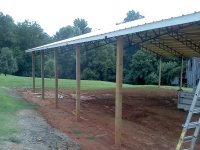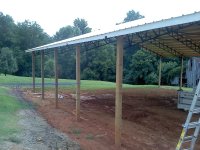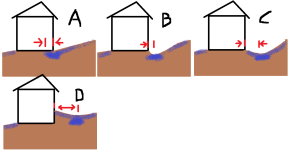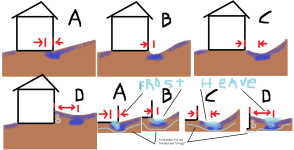boggen
Elite Member
- Joined
- Feb 22, 2011
- Messages
- 3,789
- Location
- Trivoli, IL
- Tractor
- SSTT (Sideways Snake Tain Tractor) and STB (sideways train box) tractor, dirt harvester
looking at picture.. *looks plain ugly to me* for what you have to work with. ya need to build kinda of a mini basement wall for lower portion of shed/barn. and then bring in a bunch of dirt. perhaps i am wrong. single picture and short description doesn't give a full view of the of things.
but from what i can see, the area is high "were you are standing taking picture" and goes down hill "further away form you in picture". and it looks like fairly flat land on other side of shed, so if ya did put in french drain as you have it now "needing to dig down more to install it", you going to be running a 100 plus? extra pipe to find a low enough spot on a hill side to dump the water from the french drain.
if ya cut out more dirt to make it single large nice slope, with a little bit of a ditch... are you really going to get a good grass growing? looks like shed might block out most of the sun 1/2 of the day or more?
build your retaining wall directly into wall of your shed/barn. save some costs. and bring in a good amount of dirt back in. and install a french drain, that for most part empties out a couple feet from end of the barn, or ties into the gutters down spouts.
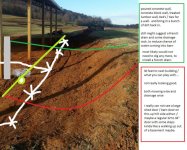
but from what i can see, the area is high "were you are standing taking picture" and goes down hill "further away form you in picture". and it looks like fairly flat land on other side of shed, so if ya did put in french drain as you have it now "needing to dig down more to install it", you going to be running a 100 plus? extra pipe to find a low enough spot on a hill side to dump the water from the french drain.
if ya cut out more dirt to make it single large nice slope, with a little bit of a ditch... are you really going to get a good grass growing? looks like shed might block out most of the sun 1/2 of the day or more?
build your retaining wall directly into wall of your shed/barn. save some costs. and bring in a good amount of dirt back in. and install a french drain, that for most part empties out a couple feet from end of the barn, or ties into the gutters down spouts.

